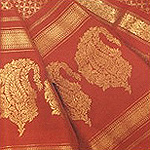
Art history/ Historiography, Crafts, Handlooms, Art
South India Heritage: Kanjeevaram Silk Saris of Tamil Nadu
Bhasin, Jyoti
November, 2009
Zilch make out a woman as being Indian so stalwartly as the sari - the exemplary Indian female piece of clothing. The origin of this magnificent garment is ambiguous due to lack of appropriate historical records though it is reckoned that it is more than 5000 years old and is mentioned in the Vedas. The 6 yard, unstitched, fluid garment is woven of myriad materials in different hues with the well known types of saris being the Kanjeevaram from Tamil Nadu, Paithani, a typical peacock and parrot motif sari from Maharashtra, Banarasi, Bhagalpuri, Odisha Ikkat, Maheshwari, Chanderi, Gujrati Patola, and Jaipuri Leheriya.
| The material and the print on the sari can vary according to choice and the occasion. The common materials for a sari are silks (the queen of textiles), cottons; chiffons, organza and georgettes. Out of these the ethnic traditional wear that is worn in most parts of the country is colourful silk saris. In collection of saris of Indian woman all around the world is incomplete without a Kanchipuram (Kanjeevaram) sari, one of India's most precious traditional treasures. Saris represent the essence of womanhood and this one adds special charm to it. The sari speaks of the beauty, grace dignity poise and also the power hidden in every single Indian woman. A Kanjeevaram sari is bound to be a crowd puller and it can woo anybody with its absolute beauty. | |
This is a preview. To access all the essays on the Global InCH Journal a modest subscription cost is being levied to cover costs of hosting, editing, peer reviewing etc. To subscribe, Click Here.
ALSO SEE
The Cultural Diversity Umbrella
Jongeward, Carolyn
Curriculum for Design Education of Craftspersons
Agarawal, Megha



